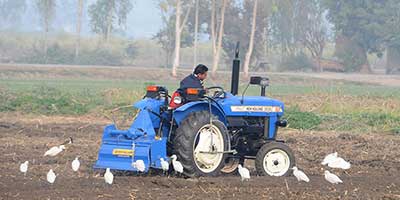Date: 21/02/2023
Relevance: GS-3: Climate Change, Agriculture Cropping Pattern and issues related to it.
Key Phrases: Central Research Institute for Dryland Agriculture, Heat Wave 2022, Heat-resistant Varieties, Climate-Risk-Prone Village Clusters, Direct Seeding of Rice, Beat-the-Heat Practices
Why in News?
- The rising February temperature in parts of western and north India has once again raised concerns over the wheat crop even though the Centre has predicted a record output of 112 million tonnes this season.
Key Highlights:
- An unprecedented heat wave in March and April resulted in a depleted output at 107 million tonnes last year after the initial projected an output of 111 million tonnes by the centre.
- A study by Central Research Institute for Dryland Agriculture, an ICAR body, on ‘heat wave 2022’ says wheat yields fell 15-25 per cent last year, owing to an extreme combination of high temperature and low rainfall in March and April.
- This was recorded in 10 out of 36 Met subdivisions, as a result of which a yield drop was observed in the case of milk, poultry, fruit and vegetables.
Wheat
-
Wheat is a Rabi Crop grown between September and December and harvested between February and May.
-
Major wheat growing states in India are Uttar Pradesh, Punjab, Haryana, Madhya Pradesh, Rajasthan, Bihar and Gujarat.
Climate Requirements:
-
The best wheat is produced in areas favoured with cool, moist weather during the major portion of the growing period followed by dry, warm weather to enable the grain to ripen properly.
-
The optimum temperature range for ideal germination of wheat seed is 20-25 C though the seeds can germinate in the temperature range 5 to 35 c.
-
Rains just after sowing hamper germination and encourage seedling blight. Areas with a warm and damp climate are not suited for wheat growing.
Soil Requirements:
-
Soils with a clay loam or loam texture, good structure and moderate water holding capacity are ideal for wheat cultivation.
-
Heavy soils with poor structure and poor drainage are not suitable as wheat is sensitive to water logging.
Central Research Institute for Dryland Agriculture (CRIDA)
-
CRIDA is a National Research Institute under the Indian Council of Agricultural Research (ICAR) established in 1985 with a mandate to carry out basic and applied research in rainfed farming.
-
The Institute also undertakes National / International Collaborations and Consultancy Projects.
-
This is the lead Institute and the National Nodal point for the National Innovations in Climate Resilient Agriculture (NICRA) which is being implemented at large number of Research Institutes of ICAR, State Agricultural Universities and 100 KVKs.
Reasons For Warmer February:
- Western disturbances responsible for bringing rain and extending wintry conditions into February and March were absent in 2022.
- They are critical to keeping India’s weather and agriculture in balance.
- In their absence, a hot, high pressure ‘anti-cyclone’ from the Arabian desert sets in. This year too, Western disturbances have been feeble.
- There is no immediate threat to crops as the nights have been cool this month, even as day temperatures have been above normal in northern, central and western regions.
What is Western disturbance?
- A western disturbance is an extra tropical storm originating in the Mediterranean region that brings sudden winter rain to the northern parts of the Indian subcontinent, which extends as east as up to northern parts of Bangladesh and South eastern Nepal.
- It is a non-monsoonal precipitation pattern driven by the westerlies. The moisture in these storms usually originates over the Mediterranean Sea, the Caspian Sea and the Black Sea.
- Extra tropical storms are a global phenomenon with moisture usually carried in the upper atmosphere, unlike their tropical counterparts where the moisture is carried in the lower atmosphere.
- In the case of the Indian subcontinent, moisture is sometimes shed as rain when the storm system encounters the Himalayas. Western disturbances are more frequent and stronger in the winter season.
Preparing To Deal With Premature Summers:
- A temperature of 15-30 degrees Celsius till March-end is ideal for wheat.
- Some weather scientists contend that the frequency of western disturbances is expected to fall in the winter months.Hence, the farm ecosystem for rabi should be prepared to deal with a premature onset of summer.
- An ICAR project has been working on heat-resistant varieties and other techniques in 151 climate-risk-prone village clusters in north and west India.
- One way to beat the heat is by ensuring that wheat is sown early.
- Direct seeding of rice with short duration varieties helps in
sowing of wheat towards the end of October.
- Crops sown towards the second week of November 2021 were badly hit.
- Quick sowing of wheat crop with ‘happy seeder’, soon after early harvest of rice resulted in near normal yields (97 per cent) last year.
- Equally good results were obtained with heat-tolerant varieties. It is important to popularise these varieties as well as beat-the-heat practices such as mulching and shading.
Conclusion:
- The wheat crop looks good with an acreage of 34.1 million hectares, marginally higher than last year.
- There are indications that early sowing has picked up but farm practices need to adapt to new climate realities.
Source: The Hindu BL
Mains Question:
Q. Discuss the climatic conditions needed for the cultivation of wheat. Suggest measures in order to deal with premature summers. (150 words).






















